From north to south, including islands, all Italian regions boast fascinating popular traditions and customs worth getting to know.
Many cities and towns over the peninsula arrange folk festivals to celebrate their cultural roots, and often even the smallest villages are enthusiastic about telling their origins and customs through particular festivals, rituals, events and re-enactments.
Ready to discover with us the beauty of the country's popular culture and most evocative traditions? Here is a selection of the best 15 folk events in Italy that are truly impossible to miss in 2025!

Folk culture and popular Traditions in Italy in 2025
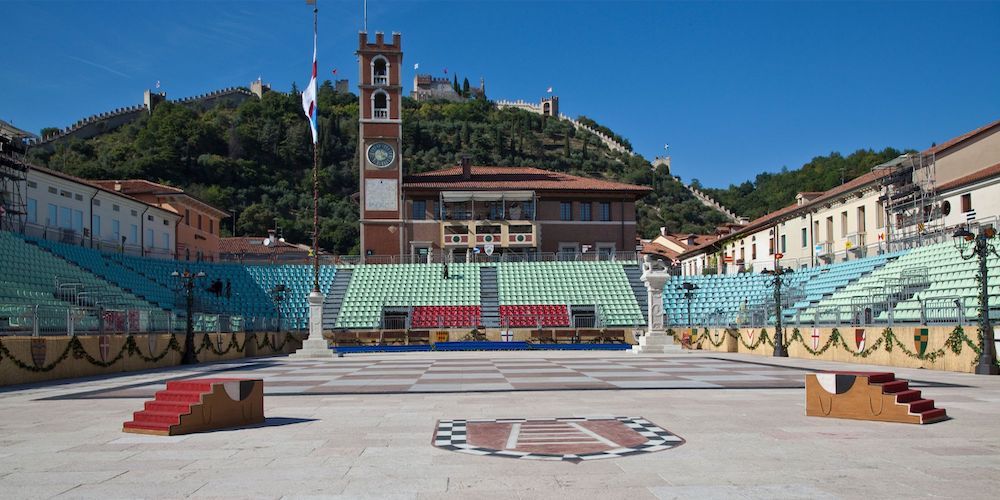
From historical reenactments to traditional dances and ancient popular rituals, Italy preserves a rich cultural heritage made up of festivals that reflect the deep connection between local communities and their roots. These events trace back centuries, often linked to religious devotion, local legends, or the rhythms of nature—yet they still resonate with contemporary visitors, offering a glimpse of an authentic and vibrant Italy.
These folk culture and popular tradition festivals engage entire towns and villages, brought to life through historical costumes, processions, contests between districts, and music and dance passed down through generations.
Let’s explore the 15 most emblematic folk events in Italy in 2025, traveling from north to south through celebrations that blend memory and identity. Some are internationally known, others are more closely tied to local traditions, but each one reveals a different side of Italy—one rooted in shared stories and collective pride.
- Battle of the Oranges in Ivrea
- Donkey Palio of Alba
- Ferrara Buskers Festival
- Palio of Siena
- Sea Festival and Graziella Celebration in Procida
- Sant’Alessandro Festival in Ischia
- Sant Miquel Festival in Alghero
- Feast of the Blessed Virgin of the Defense in Stintino
- Night of the Taranta
- Cous Cous Festival in San Vito Lo Capo
- Festival of the Lilies in Nola
- Mascio Festival in Pietrapertosa
- Barbarians Festival in Castel Rigone
- The Macchina di Santa Rosa in Viterbo
- Living Chess Game in Marostica
15. Folk events in Italy: Oranges Carnival in Ivrea
Let's start this journey discovering folk events in Italy with the Carnival, a very popular and colorful celebration over the Peninsula. It is an opportunity to enjoy the city with colour and fun, wearing traditional clothes that often symbolise traditional events. In Ivrea, Piedmont, the carnival coincides with the famous 'Battle of the Oranges' between the city's contrade (districts in medieval Italian).
The inhabitants of the four contrade of Ivrea wear the typical colours of their township and, as they ride through the streets of the town on floats, throw large oranges at each other as if they were water balloons, which inevitably also hit the spectators walking through the streets.
This festival is linked to the ideals of freedom of the French Revolution, so all participants are required to wear a red Phrygian cap, and those who don't wear it are targeted by the orange-throwers on the floats.
The heroine of the festival is the "Mugnaia", identified by sources as Violetta, the miller's daughter, who was dragged to the castle by the local lord who demanded the "ius prime noctis", a medieval practice that obliged girls to spend their wedding night with the feudal lord; legend has it that Violetta got the lord of the castle so drunk that he fainted before consummating the act, she cut off his head and started the popular uprising to free the town from an oppressive government.
- The dates for the Ivrea Carnival in 2025 are March 1st, 2nd, 3rd, and 4th, with the traditional Battle of the Oranges scheduled for Sunday, March 2nd.
14. Donkeys Palio in Alba
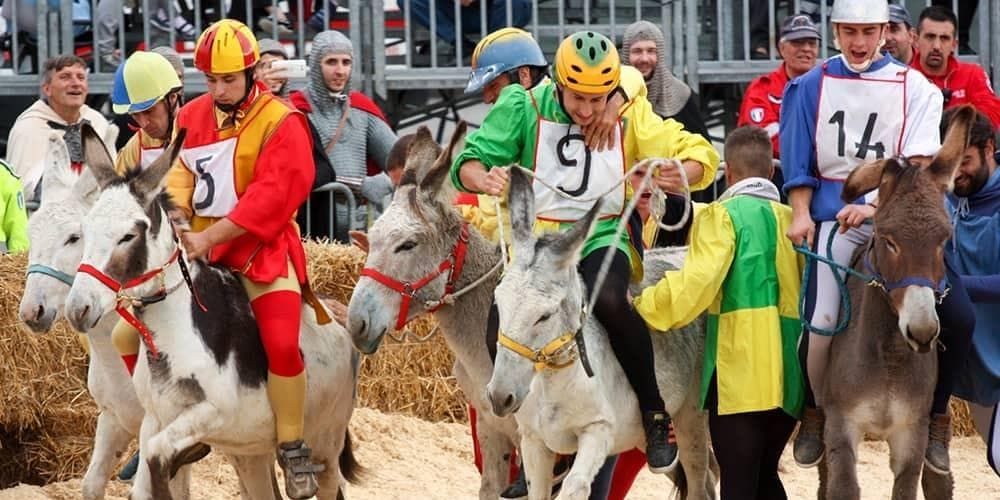
On the first Sunday in October, noble ladies, brave knights, commoners, peasants and flag-waver’s flock to the streets of Alba to celebrate a fun and traditional goliardic event: the Palio degli Asini.
This is a hilarious challenge that takes place on the backs of donkeys that trot through the streets of the city, in a cheerful and very folkloric competition. This challenge celebrates the historical tradition of the city of Alba in the context of the International Fair of the White Truffle of Alba: fun and taste will be the protagonists of these beautiful days in the hills of Piedmont where there will be the excellent wine of the area such as Barbaresco and Barolo.
- In 2025, the Palio degli Asini in Alba is scheduled for Sunday, October 5th.
13. Ferrara Buskers Festival
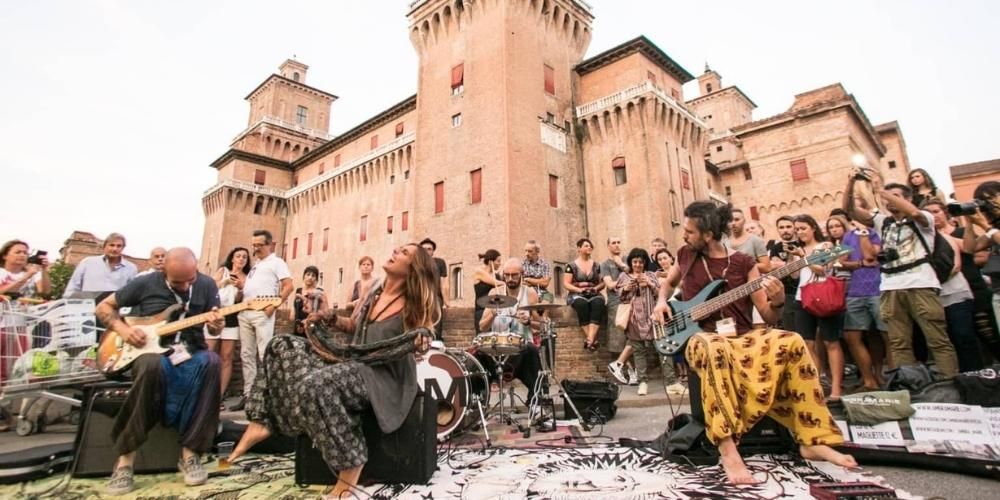
The most beautiful street festival in Italy takes place in Ferrara at the end of August and will leave you breathless with wonder: the medieval city of Emilia is completely dressed up and in every street you can find a young artists who will delight you with all kinds of art, from music to acting, from visual arts to circus.
Street art has a long tradition in Italy, where creativity is often displayed outdoors, taking advantage of the architectural and scenic beauty of our country. The circus and street art tradition will involve and transport you into a world of ancestral fascination, where grace and harmony are displayed in the streets and squares of the city, within everyone's reach.
- In 2025, this iconic event celebrating folk culture and popular traditions in Italy will take place from August 27th to 31st.
12. Palio di Siena
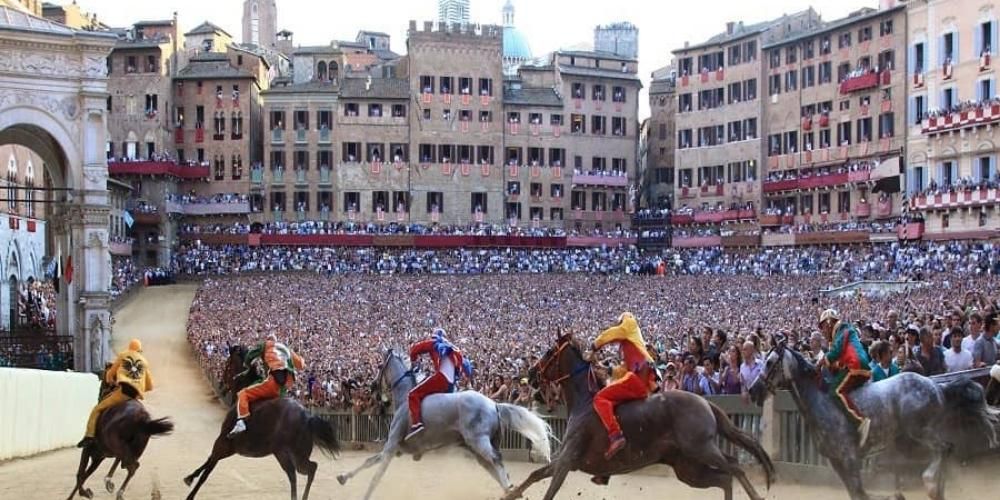
The Palio di Siena is a competition involving the city's seventeen contrade and takes place in the form of a medieval equestrian joust.
The race takes place twice a year between July and August in the amazing Piazza del Campo and sees tourists and inhabitants flocking to every possible corner of the area, to the grandstands, to the balconies of the houses that are 'rented' by the inhabitants for the occasion and wherever there is a chance to watch the race.
The first recorded Palio dates back to 1633 and since then it has been held on an annual basis (except during the world wars) and over the centuries has created precise relationships of alliance or rivalry between the various contrade: the alliances involve real exchanges of gifts and visits, sharing of celebrations in the event of victory and favourable treatment during the negotiations preceding the Palio, while the rivalries are expressed mainly during the competition.
The Palio in Italy is an ancient form of entertainment, and other cities besides Siena preserve this fascinating tradition. A true plunge into the knightly Middle Ages!
- The two annual races in 2025 are scheduled for July 2nd and August 16th.
11. Procida's Sea Festival and Graziella Festival
Alphonse de Lamartine, like many other intellectuals of his time, made the ritual trip to Italy during his youth, which brought young people closer to classical culture and Renaissance beauty.
From his stay in Campania he took inspiration for his famous novel 'Graziella', and from his work the inhabitants of Procida took inspiration for their traditional Sea Festival that celebrates the island's indissoluble bond with the marvellous sea that embraces it.
The top moment of the celebration is the election of 'Graziella', the most beautiful girl on the island. A summer festival not to be missed, traditionally held in July in the beautiful setting of the Italian Capital of Culture 2022!
- The 2025 Sagra del Mare will take place between July 16th and 30th.
10. St. Alexander's Festival in Ischia
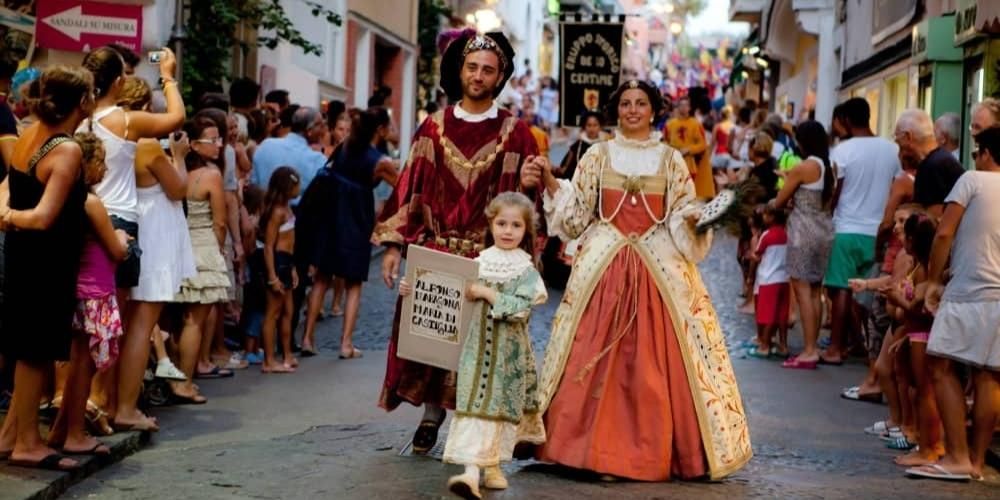
Also in Campania, on the enchanting island of Ischia, there is the annual festival of St. Alexander on August 26, during which a colourful procession of participants parade through the narrow street in traditional costumes, starting from the Aragonese Castle and ending at the port.
Among the participants, you will be able to identify the Greek colonists of Pithecusa, the Romans in their purple robes and the fluffy stately clothes of the families that ruled the island for centuries, such as the Ferrante, Colonna and Bourbon families.
Among the participants, you will also recognise those who pay homage to the island's typical jobs such as fishermen, farmers and fan weavers. At the end of the procession, a mass is held in Borgo Sant'Alessandro, after which you can celebrate with a rich banquet of traditional products.
- Also in 2025, the event will take place on August 26th in the enchanting setting of Ischia.
9. Sant Miquel Festival in Alghero
In the fantastic Coral Riviera in the north of Sardinia lies the town of Alghero, a wonderful urban centre overlooking the sea where the architecture, language and customs are based on the Catalan tradition. Here in this stunning setting it takes place the Sant Miquel Festival, a folk festival paying homage the city's patron in the second half of September.
The calendar of events is extremely varied, from music concerts featuring artists like Antonello Venditti, and completely original events such as the Cooking Cup (a sailing and culinary regatta), to street performances with clowns and puppets. In addition to these, editorial reviews, author aperitifs, and appointments dedicated to the future of tourism, such as workshops focusing on gamification to promote the city's cultural heritage through the dynamics of game design.
One of the most important festivals in Sardinia, straddling past and future. For more information, consult the calendar of Salude & Trigu, a project created by the Sassari Chamber of Commerce to enhance the value of the hinterland and all the most fascinating events in Northern Sardinia.
The Sant Miquel Festival is part of a broader landscape of popular celebrations in Northern Sardinia, where centuries-old traditions continue to thrive through events of great symbolic impact, such as the evocative Discesa dei Candelieri in Sassari.
- In 2025, the Festival will take place between September 14th and 29th.
Discover Salute & Trigu and traditions of Northern Sardinia8. Festival of the Blessed Virgin of Defense in Stintino
Sardinia is a land that boasts a popular culture rich in traditions and events. Here, the village of Stintino stands out rising in one of the most beautiful settings on the island; it was founded by 45 families from Asinara who were forced to leave their homes.
The patronal feast of the village is dedicated to the Beata Vergine della Difesa (Blessed Virgin of Defense). It commemorates when, in 1885, the simulacrum of the Virgin was carried by boat from Asinara to Stintino.
The suggestive seaside procession involves the inhabitants and representatives of the religious confraternity 'Beata Vergine della Difesa' in their typical dress, but also by local authorities and Sardinian folk groups. It's also a very evocative moment for visitors who can participate in a traditional folk festival that includes shows, entertainment and the inevitable Sagra del Pesce (Fish Festival) in Piazza dei 45.
- The Festival of the Blessed Virgin of Defense is celebrated every year in Stintino on September 8th.
7. Notte della Taranta
The Notte della Taranta is one of the biggest festivals in Italy and one of the most significant manifestations of popular and folk culture across Europe.
The event takes place every year in August in Salento in the municipality of Melpignano, in the esplanade of the Augustinian convent, and attracts many Italian and international musicians as well as large crowds of tourists who are spending the summer in Apulia.
The folklore of Taranta involves many villages across the region anyway, a tradition that is exported even outside Salendo with a lot of excitement and success.
The event is mainly dedicated to the promotion of traditional music from Salento and its fusion with other musical categories such as rock, jazz and symphonic music.
The main protagonist is the 'pizzica', a stunning lively dance that goes back to the ancient tradition of the ritual of healing from the bite of the tarantula, a spider present in the region during harvest time.
Its bite caused a general malaise that could only be cured with music: the sick person would start to shake from head to legs, crawling on his back, keeping close to the ground and thus identifying himself completely with the figure of the spider and thus recovering from its bite.
- To attend the Notte della Taranta 2025, head to Melpignano on August 23rd.
6. CousCous Festival at San Vito lo Capo
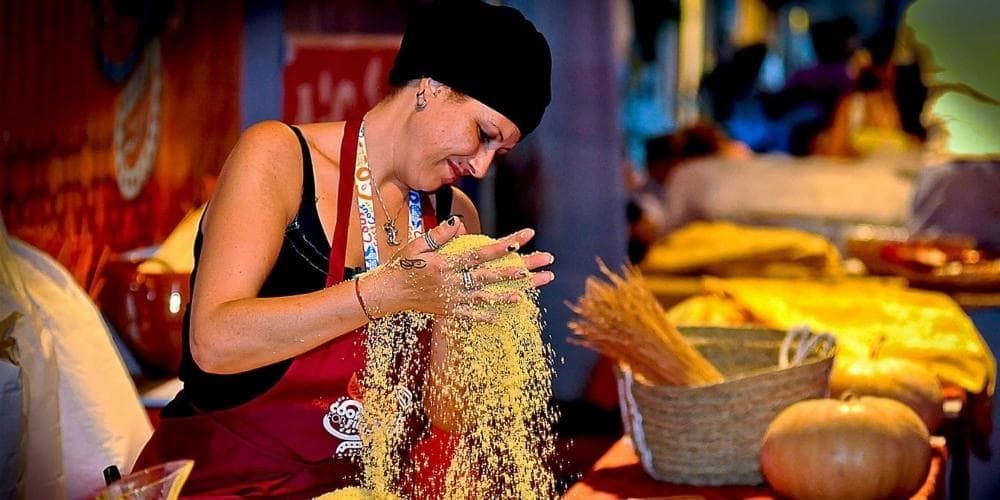
To celebrate Italy's cultural traditions, we cannot forget our Mediterranean origins, especially in Sicily. On this sunny and beautiful island, one of the typical dishes is couscous, a traditional Maghreb dish found nowhere else in Italy except in Sicily, which thus manifests its strong bond with North Africa.
Over the years, the event has consolidated its position as a festival of cultural integration, with the grains of cous cous semolina becoming a symbol of brotherhood between peoples through food, but also of the enhancement of regional peculiarities.
However, the event is not just about food, there are also wonderful concerts, cultural activities and shows.
Immerse yourself in the folkloric heart of the Mediterranean and experience being halfway between the European and African continents! The Cous Cous Festival is held annually in the second half of September in San Vito lo Capo.
- Don’t miss the CousCous Festival 2025, taking place from September 19th to 28th.
5. Gigli Feast in Nola
The Gigli Feast of Nola is an explosion of colors, music and devotion which is celebrated every year on the occasion of the festival dedicated to San Paolino, patron saint of the city. Eight gigantic obelisks made of wood and papier-mâché, called Gigli, parade through the streets plenty of dancing and singing, carried on the shoulders of hundreds of devotees. Each of them represents an ancient guild and evokes religious and mythological stories.
The festival, acknowledged as part of the UNESCO Heritage, is a unique combination of tradition and faith that involves the whole community of Nola in a whirlwind of emotions. A folkloric experience to enjoy at least once in a lifetime to immerse yourself in the popular culture of Campania and in the magical atmosphere of this festival.
- In 2025, the Gigli Feast will take place from June 20th to 22nd, while the traditional Ballata dei Gigli is scheduled for June 29th.
4. Mascio Festival in Pietrapertosa
Every year, on the Sunday following June 13, the village of Pietrapertosa in Basilicata revives for the Mascio Festival. This is a truly ancient arboreal ritual that celebrates spring through the metaphorical bond between two trees, an oak and a holly.
The two plants, chosen and cut in the local woods a few days before, are sumptuously transported to the town on carts pulled by oxen. The grafting between the two trees takes place on the morning of the feast, symbolizing the sacred union and rebirth while celebrating the figure of St. Antonio at the same time. The Mascio, that is the new tree, is then erected as a symbol of prosperity and propitiation for the summer harvest.
The Mascio Festival is an opportunity to immerse yourself in the ancient Lucanian traditions and to admire the devotion and attachment to nature of these people. A unique event that combines folklore, history and spirituality in a suggestive and engaging atmosphere.
- June 14th and 15th are the dates of the 2025 edition of the Festa del Mascio.
3. Barbarians Festival in Castel Rigone
In Castel Rigone, among the evocative Umbrian hills near Passignano sul Trasimeno, every year it’s possible to travel back in time with the Barbarians Festival. A full immersion in the era of the barbarian invasions, recalling the legendary foundation of the village by the warrior Riggo.
Ancient folk songs and music with a celtic flavor echo through the alleys of the town, with a parade of warriors in shining armor and citizens in old style clothing. Ancient craft markets sell typical products and artifacts, especially in wood and iron, while taverns offer the most delicious traditional dishes.
In the evening the atmosphere turns so evocative with fireworks shows and duels between the warriors of the village, culminating in the spectacular final battle. An unforgettable experience for lovers of historical re-enactments to feel the emotions and discover the customs of a distant era.
- The 41st edition of the Barbarians Festival will bring Castel Rigone to life from July 30th to August 3rd, 2025, with historical parades, mock battles, and a timeless atmosphere.
2. Santa Rosa’s Macchina in Viterbo
Every year, on the evening of September 3, Viterbo lights up and gets moved by the extraordinary Santa Rosa’s Macchina. The protagonist of the event is an imposing votive machine, approximately 30 meters tall and weighing several tons, which is transported rigorously on shoulders by approximately one hundred laborers, called Santa Rosa’s porters, through the narrow streets of the historic center of the city.
The Macchina, a true work of art that is renewed every year, is a true wonder of lights, colors and religious symbols representing the profound faith of the people of Viterbo to their patron saint, Santa Rosa, celebrating her transfer to the church dedicated to her.
The procession is a moment of great emotion and participation, where the sacred and the profane intertwine in a unique atmosphere. A folk event of Italian culture and tradition that’s truly unmissable for those who want to admire devotion and artistic mastery.
- For those in Viterbo on September 3rd, 2025, the Macchina di Santa Rosa is an experience to be lived and discovered.
1. Folk events in Italy: the Living Chess Game of Marostica
The Living Chess Game of Marostica is a historical re-enactment held every two years, on the last Sunday of June, in one of most beautiful villages in Veneto in the province of Vicenza.
It is a real outdoor show staging a particular chess game, in the evocative setting of Piazza degli Scacchi (Chess Square) and the city’s castle, with the participation of...living pawns!
The slots of the chessboard are represented on the floor of the square and the pawns, main protagonists of the most bizarre chess game ever, are impersonated by people figuring in period costume ready to battle guided by the moves of two exceptional players, respectively the heads of the two rival noble families of the city. The two characters are represented by two standard bearers on horseback.
The game, which retraces a curious renaissance historical event following the ordinary classic rules of chess, takes place with great precision and above all involvement from the public, as well as from the protagonists in action on the iconic chessboard of Marostica. A truly unique folk event that brilliantly combines history, tradition and entertainment.
- The picturesque Living Chess Game of Marostica takes place only in even-numbered years: the next edition is therefore already scheduled for 2026, on September 4th, 5th, 11th, and 12th.
About the author
Written on 29/06/2024



Gloria Venturini
In Italy there are many events related to folk culture and traditions, spectacular and engaging for all. Let's discover the best Italian folk events!